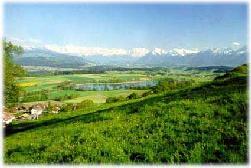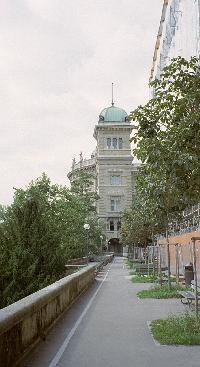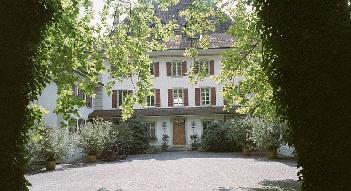The Ninth Inforum World Conference at Gerzensee, Switzerland

The ninth conference was held in Gerzensee, Switzerland, from September 9 to September 15, 2001.
Here is a brief summary of the papers and events of the conference:
 Sunday,
September 9
Sunday,
September 9
After tiring trips by planes, trains and automobiles, we settled into the comfortable Gerzensee conference center. The weather and the countryside were beautiful. Some attendees went on bicycle or walking excursions while others paused to taste the apples. Dinner was at the elegant Golden Kreuz.
- Monday, September 10
- The morning started off with the welcome addresses by Gabrielle Antille and
Clopper Almon. Most of the talks of the day were comprised of an extensive review of
activities by several Inforum partners.
Dirk Vanwynsberghe (Belgium) reviewed some of the work his company ERI has been involved in over the last two years. This includes the development of strategic planning models, as well as a project with statistics databases for Unido. This work has involved the structuring of a multitude of databases into a common database-oriented framework, with a friendly user interface.
Li Shantong described the 10th 5-year plan in China, which is nowdays less like planning, but more like a forecasting exercise. She is also involved in China WTO negotiations in Geneva. Wang Yinchu is building a provincial model of the Jiang-su province.
Peter Rormose (Denmark) described progress on the Dandy model, including the new PADS estimation, and the treatment of consumer durables within the system. He will soon be attempting to build the Danish ADAM model in Interdyme. He has also been a partner in work with the Italian and French partners of the investigation of the enlarging of the EU by 5 countries by 2005.
Paul Salmon (France) described how he was picking up speed on work with the FUR model, and anticipated a visit to Maryland in January 2002, with completion of the model by February. He also has a large project for the UN Development Project to build models for African countries.
The German team has been very busy, and Christian Lutz was the spokesman, as Bernd Meyer was not yet present. He described how the new company GWS is totally self-financed, and doesn't receive funds from the university of Osnabrueck. GWS is the only company in Germany now that markets an I-O based model. GWS has a project with the Federal Statistical Office to create a time series of I-O tables from 1991 to 2000. This work will primarily be done by Martin Distelkamp. The Ministry of Labor is also a client, and uses the model software. GWS is doing a project for the Ministry of Finance involving the effects of environmental tax reform, about which Bernd will speak later in the conference. They are also doing a study for the regulation authority of the telecommunications market on the effects of liberalization. For the Ministry of Research and Education, GWS is looking into the question of how innovation can be modeled in an interindustry model. For the 16 Bundeslaender, GWS has developed a model of 11 sectors by 16 regions. For a large commercial bank they are working to develop a forecast at a very detailed level, up to 800 sectors. Finally, Frank Hohmann has done several projects to improve the user interface to the model, including an interface for developing fixes, and a Visual Basic program to read a G-bank into Excel.
Maurizio and Rossella (Italy) have both participated in the project to study the eastern enlargement of the EU. Maurizio will speak about this project on Tuesday morning. They have built a new version of INTIMO, based on the ESA95 (ESA = European Statistical Accounts). Maurizio has published the proceedings from last year's conference in a new volume entititled Contributions on Multisectoral Modeling, Volume I. They are also participating in a group which has been set up to build regional I-O tables of Italy.
Doug Meade described some of the activities of the U.S. group. The version of LIFT in Interdyme, called IdLift, is now the main U.S. model, and was used for the Spring, 2001 forecast. Inforum Maryland will hold an Outlook conference on November 14. The long-run 2080 model is now also the IdLift model, and Margaret McCarthy is using this in consulting with the Health Care Finance Administration. Doug Meade continues to work with the Department of Defense, and delivered a paper on a comparison of defense cost deflators at the Western Economic Association in July. For a company named Integra, Inforum produces forecasts at a detailed level of 850 sectors. In a project for NRECA (the National Rural Electrical Cooperative Association), Inforum constructed a satellite model to LIFT, which produces forecasts for 3140 counties and 3496 electric utilities. Inforum has also provided input and support to the Digital Economy 2001 project by the Department of Commerce. Doug Nyhus continues to develop the Mudan model with Mike Field and Li Ding, and has produced a new model of India. SooHee Lee visited us over the academic year 2000-2001, and work was done on the Kiosk model of South Korea, as well as beginning a study of a U.S.-Korea free trade area. Clopper Almon and Doug Meade continue to refine G7 and Interdyme, and Clopper will discuss the new model optimization features of G7 on Tuesday.
Prof. Hasegawa and Prof. Imagawa discussed the work of the Japanese team, which consists of Chuo University and the International Institute for Trade and Investment (IITI). Unfortunately, Mr. Sasai was unable to join us this year. Mr. Sasai has completed a Japanese translation of The Craft of Economic Modeling, which includes a Japanese version of the AMI model, named JAMI. Hasegawa announced that a revised version of the Jidea model of Japan will be ready by March 2002, which will be version 5. They have also worked this year with Shuntaro Shushido, in a project funded by MITI. A paper was published last year on the Accountant in the Jidea model. IITI did a study on the influence of foreign direct investment on the U.S. and Japan. They also did a study with SooHee Lee of Korea on a Japanese Korea free trade area, presented on Tuesday. Finally, they completed an analysis of the reform by the new Koizumi cabinet, which is presented on Friday. Prof. Hasegawa also supplied a written report.
Lucja Tomaszewicz (Poland) described how she is using SAM's to extend the Accountant in IMPEC. Mariusz has been working hard this year to complete his habilitation, as well as to do a study focusing on the interaction of small and medium business enterprises with the rest of the economy. The Polish group has also done preliminary study on the impact of joining the EU.
Lindy Mulder (South Africa) described some of the activities of Conningarth Economists. They are a non-government, non-university firm, fully self-funded by projects and contracts. Their projects include macroeconomic impacts, sectoral analysis, as well as regional analysis. The model is a closed I-O model, but not built using Inforum software. They are now developing a SAM for 2000, and have collaborated with Statistiks South Africa on an earlier SAM. They recently completed and published a book of sectoral analysis for a large bank. They are also starting a project for the U.S. Agency for International Development to study a plan to develop carbon sinks. Finally, they have done a study for ISCOM, which produces an electric generator, which is a small, portable nuclear power station.
Samuel Guillet (Switzerland) discussed the work with the SWIMM model over the last year, including the development of value added equations, labor productivity, and several model runs. He plans to complete the model in December, and will be starting a job at the beginning of October.
After the coffee break, Doug Meade presented the What's New in Inforum Software. Highlights include enhanced portability of Interdyme, new optimization capabilities in G7, and a new /rtf command for Compare. Also, most of the features of G7 are now present in G6 for DOS. Finally, a new G7 Reference has been compiled, covering both G7 and G6.
The evening was capped off by a presentation by Dirk on his computer of GloDym, their Global Dynamic Modeling system. He discussed and demonstrated the user interface, the object-oriented database approach, and the links with G and Interdyme. He also showed a nice piece of software written by Frank Hohmann of the German team, named DataView. This allows one to view a Vam file graphically. 
- Tuesday, September 11
- Those of us who were up at the crack of dawn jogged or rode bicyles through the beautiful countryside overlooking the river Arre, with the Alps in the distance. Others strolled through the Gerzensee complex, enjoying the weather and the view.
Morning: Session I - An Economic Integration Session
Scenarios for Evaluating the Impact of Eastern Enlargement of the EU, by Maurizio Grassini.[Abstract]
FUR and European Integration, by Paul Salmon.
The Economic Influence of a Japan-Korea Free Trade Area, by Toshiaki Hasegawa.
Afternoon: Session II - Inforum Problems and Improvements:
Some Reflections on the Empirical Foundations of Inforum Models, by Josef Richter. [Abstract]
The Fundamental Identities with Heterogeneous Prices and Imperfect Economic Accounts, by Douglas Meade. [Abstract]
Experience with Optimization in Inforum Models, by Clopper Almon. [Abstract]- Wednesday, September 12
- Morning: Session III, A Tax Effects Session
Macroeconomic and Structural Effects of the German Environmental Tax Reform, by Bernd Meyer. [Abstract]
Stochastic Simulations with the Model PANTA RHEI, by Christian Lutz. [Abstract]
Tax Policies - SAM-based Multipliers for Poland, by Lucja Tomaszewicz and Jakub Boratynski. [Abstract]
After lunch, we were taken to a tour of the old town of Bern. From there, we went to Neuchatel, for a tour of the OFS (Swiss Federal Statistical Office) and a reception cocktail with Carlo Malaguerra, the Director-General of OFS. Finally, we had a wonderful dinner at the Schiff am See Hotel in Murten/Morat, by the lakeside. - Thursday, September 13
- Morning: Session IV - Labor Productivity, SWIMM Model
The Effect of Technical Change and Capital Investment on Labor Productivity and Employment in the Italian Model, by Massimiliano Iommi. [Abstract]
New Productivity Equations for IMPEC: The Concept and First Results, by Michal Przybylinsky and Iwona Swieczewska. [Abstract]
Value Added in SWIMM, by Samuel Guillet.
Afternoon: Session V
A Dynamic KLEM Factor Demand System for Dandy3m, by Peter Rormose Jensen. [Abstract]
The Analysis of Welfare Effects in INTIMO: A Preliminary Study, by Rossella Bardazzi. [Abstract]
A Note on Scaling, by Michael Field.
Computer Demonstration: Visual Basic for Economists, by Frank Hohmann.
- Friday, September 14
- Morning: Session VI
A Regional Submodel for Andalusia: A Project for the Andalusian Regional Government, by Elena Alonso [Abstract]
The Role of Small and Medium Enterprises: Scenarios for Poland, by Mariusz Plich [Abstract]
Effects of Koizumi's Structural Reform Plan on the Japanese Economy, by Takeshi Imagawa [Abstract]
Afternoon: Session VII
Capital-Embodied Technological Change: Measurement and Productivity Effects, thesis of Dan Wilson, summarized by Clopper Almon. [ Above link is to a 1.4Mb PDF file! ]
Planning of Future Work
- Saturday, September 15
- Unfortunately, by Saturday morning, Li Shantong, Elena Alonso and the German group had left us. The rest of us went on an excursion to the nearby city of Thun, and visited the castle museum. We dined on venison at the restaurant Krone, and then on the the historical museum in Ballenberg, which has Swiss dwellings from the 14th to the 19th centuries. Some of us said good-bye on Saturday evening, but there was still a good crew on hand for departure on Sunday morning.




